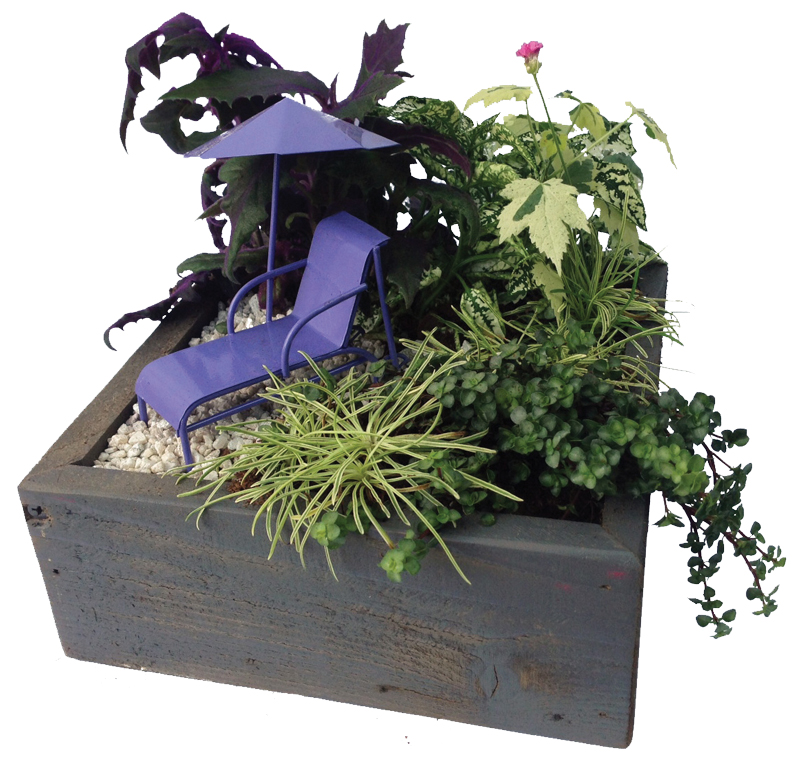
The New Shoulder Crop
Here at Gulley Greenhouse we were looking to increase sales around the peak season. We have the space, people on the clock, and during certain points, free heat. However, finding a consistent program to justify the expense has often been the illusion. We all have our niche programs, they can be glorious one year, only to make the dumpster service happy the next. Where do we find a programmable crop that doesn't mean the reinvention of our customer base year after year?
I remember quite well back in 2009 having a beer, well, maybe a couple beers, with Jeff and Emily Sorenson of Rabbit Shadow Farms. We had been discussing their 'niche' Fairy Gardening program. Jeff and Emily were a few years into the program, planting the leftovers from spring sales into miniature garden concoctions. They were remarking that the retailers were repeatedly asking for the same items, wanting to see consistency within the gardens. It was then Jeff, Emily and I realized, we needed a program. One that not only gives growers a defined listing of plants, but can more importantly allow scheduled and reliable finished times. This eliminates the "when it's ready" garden.
The Beginning of Fairy Flowers
Gulley Greenhouse and Rabbit Shadow Farms started Fairy Flowers in 2010 at OFA Short Course with 28 line items, three tray sizes and thick skin for the coming onslaught. While we were prepared with catalogs, displays and speculative liner availability, we did not realize the hunger for a new "shoulder crop." With the Fairy Gardening program being strong year round, our greatest sales are outside weeks 18 through 22. We didn't need to stare at a poinsettia for 20 weeks or keep a mum happy in 100 degrees, we found a crop that the consumer actually wanted and could turn the bench in as little as three to four weeks. With Fairy Flowers and Fairy Gardening being trademarked, we could be sure the end user would have the same results regardless of their location.
Three Unique Programs
The Fairy Flowers program has grown into three distinct categories: Original Fairy Flowers, Terrarium Fairy Flowers and Gargoyle Gardening Succulents. Across all three there is a wide range of perennial items, tropical varieties and succulents; 62 varieties in total. Each series maintains its own unique flavor, yet the plants are cohesive enough to make scheduling bench space far more simplistic.
With three tray sizes of 25, 96 or 196, both retail and wholesale growers can scale the program to what works best for them. Our product listing suggests finish times, as well as the plants desired use; what works best as a ground cover, shrub and tree. Here at Gulley we plant into a 7-inch square wooden garden allowing space for five plants as well as furniture. We also offer 3-inch pots as single variety trays (12 per) or assorted trays for a small upcharge.
Culture Tips
The main distinction when scheduling space is to adhere to the three distinct programs. Segregation of Fairy Flowers, Terrarium Fairy Flowers and Gargoyle Succulents is simple and saves labor hours through the crop time. These can certainly share the same house, but separate bench space will allow growers to move through water and applications with ease.
Nights should remain 58 to 60¡ F to ensure finish times remain uniform through the three divisions. We recommend a 3-inch pot, as this provides enough soil base, while still being small enough to allow the end consumer to purchase multiple items for a small space. A constant feed, lower in nitrogen such as 16-3-16, at 100 ppm is sufficient and cost effective while minimizing stretch. Generally one application of RootShield or Decree can get you through the complete crop time and is effective on all the line items. Insect pressure is a seasonal issue, with Aphids being the main diner. Whiteflies can also be present if they are a common guest. We have seen good results with Endeavor at 5 ounces per 100 gallons. SuffOil is also in rotation, as a mild but effective insecticide with fungicidal attributes. Perhaps the greatest feature to this product line is that it is expected to be small! Use of plant growth regulators is rare as the benches turn quickly, often when the plants are just rooted to the sides. But PGRs can be used on the Fairy Flower line; 1-ppm Bonzi drench applied at _ desired plant size has shown excellent shelf life. An application of 2,500-ppm B-Nine also works nicely as a foliar spray. The Terrarium plants benefit best with a cutback, as with most tropical line items, they can be less than thrilled with too many chemical components. The Gargoyle line of succulents do not require any PGRs and may just need a wild hair trim if held past prime. We have both liner lead time and finish times available at request.
Giving the consumer the correct tools to be successful is an integral part to the success and longevity of the program. Many of our liner customers have shown us unbelievably creative gardens. I have been fortunate enough to see many of their displays throughout the nation and have been constantly impressed with their use of Fairy Flowers and hardgoods.
Allow yourself and your customers an opportunity to harvest off-season dollars. Fairy Flowers is brokered exclusively through the Henry F. Michell Company.
The New Shoulder Crop


 Video Library
Video Library 




















